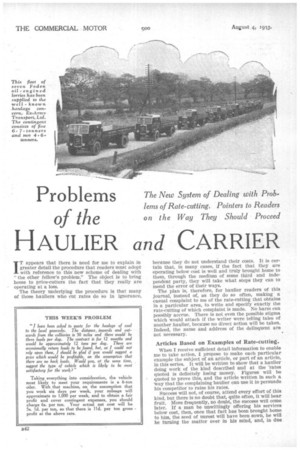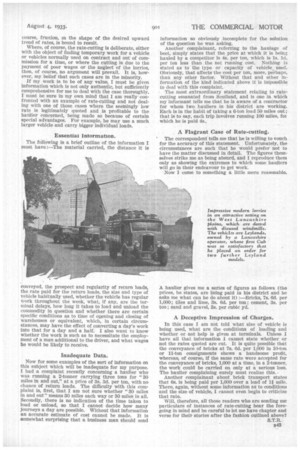Problems of the
Page 52

Page 53

If you've noticed an error in this article please click here to report it so we can fix it.
HAULIER and CARRIER IT appears that there is need for me to explain hi greater detail the procedure that readers must adopt with reference to this new scheme of dealing with 'the other fellow's problem." The object is to bring home to price-cutters the fact that they really are operating at a loss.
The theory underlying the procedure is that many of those hauliers who cut rates do so in ignorance, because they do not understand their costs. It is certain that, in many cases, if the fact that they are operating below cost is well and truly brought home to them, through the medium of some third and independent party, they will take what steps they can to mend the error of their ways.
The plan is, therefore, for haulier readers of this journal, instead of, as they do so often, making a casual complaint to me of the rate-cutting that obtains in a particular area, to write and specify exactly the rate-cutting of which complaint is made. No harm can possibly accrue. There is not even the possible stigma which would attach if the writer were telling tales of another haulier, because no direct action will be taken. Indeed, the name and address of the delinquent are not necessary.
Articles Based on Examples of Rate-cutting.
When I receive sufficient detail information to enable me to take action, i propose to make each particular example the subject of an article, or part of an article, in this series. It will be written to show that a haulier doing work of the kind described and at the 'rates quoted is definitely losing money. Figures will be quoted to prove this, and the article written in such a way that the complaining haulier can use it to persuade his competitor to raise his rates.
Success will not, of course, attend every effort of this kind, but there is no doubt that, quite often, it will bear fruit. More frequently, no doubt, the success will come later. If a man be unwittingly offering his services below cost, then, once that fact has been brought home to him, the seed of unrest will have been sown, he will be turning the matter over in his mind, and, in due
course, fruition, in the shape of the desired upward trend of rates, is bound to result.
Where, of course, the rate-cutting is deliberate, either with the object of finding temporary work for a vehicle or vehicles normally used on contract and out of commission for a time, or where the cutting is due to the payment of poor wages or the neglect of the lorries, then, of course, no argument will prevail. It is, however, my belief that such cases are in the minority.
If my work is to be of any value, I must be given information which is not only authentic, but sufficiently comprehensive for me to deal with the case thoroughly. I must be sure it my own mind that I am really confronted with an example of rate-cutting and not dealing with one of those cases where the seemingly low rate is legitimately quoted and is profitable to the haulier concerned, being made so because of certain special advantages. For example, he may use a much larger vehicle and carry bigger individual loads.
Essentiat Intormatton.
The following is a brief outline of the information I must have :—The material carried, the distance it is conveyed, the prospect and regularity of return loads, the rate paid for the return loads, the size and type of vehicle habitually used, whether the vehicle has regular work throughout the week, what, if any, are the terminal delays, how long it takes to load and unload the commodity in question and whether there are certain specific conditions as to time of owning and closing of warehouses or equivalent, which, in certain circumstances, may have the effect of converting a day's work into that for a day and a half. I also want to know whether the work is such as to necessitate the employment of a man additional to the driver, and what wages he would he likely to receive.
Inadequate Data.
Now for some examples of the sort of information on this subject which will be inadequate for my purpose. I had a complaint recently concerning a haulier who was running a 2-tonner carrying three tons for "30 miles in and out," at a price of 3s. 3d, per ton, with no chance of return loads. The difficulty with this complaint is, first, that I am not sure whether "30 miles in and out" means 30 miles each way or 30 miles in all. Secondly, there is no indication of the time taken to load or unload, so that I cannot decide how many journeys a day are possible. Without that information an accurate estimate of cost cannot be made. It is somewhat surprising that a business man should send information so obviously incomplete for the solution of the question he was asking. Another complainant, referring to the haulage of beet, simply states that the price at which it is being hauled by a competitor is 45. per ton, which is 1s. 1d. per ton less than the net running cost. Nothing is stated as to the type or capacity of vehicle used. Obviously, that affects the cost per ton, more, perhaps, than any other factor. Without that and other information of the kind indicated above it is impossible to deal with this complaint.
The most extraordinary statement relating to ratecutting emanated from Scotland, and is one in which my informant tells me that he is aware of a contractor for whom two hauliers in his district are working. Each is in the habit of taking a 6-ton load 50 miles out; that is to say, each trip involves running 100 miles, fox which be is paid 48.,
A Flagrant Case of Rate-cutting.
The correspondent tells me that he is willing to vouch for the accuracy of this statement. Unfortunately, the circumstances are such that he would prefer not to have the matter discussed in detail. The figures themselves strike me as being absurd, and I reproduce them only as showing the extremes to which some hauliers will go in their endeavour to get work.
Now I come to something a little more reasonable.
A haulier gives rue a series of figures as follows (the prices, he states, are being paid in his district and he asks me what can he do about it) :—Bricks, 75. 6d. per 1,000; tiles and lime, 3s. 6d. per ton ; cement, 3s. per ton ; sand and gravel, 3s. per cubic yd.
A Deceptive Impression of Charges.
In this ease I am not told what size of vehicle is being used, what are the conditions of loading and whether or not help is given at terminals. Unless I have all that information I cannot state whether or not the rates quoted are cut. It is quite possible that the conveyance of bricks at 7s. 6d. per 1,000 in 10-ton or 11-ton consignments shows a handsome profit, whereas, of course, if the same rate were accepted for the conveyance of bricks, 1,000 at a time, in a 2-tonner, the work could be carried on only at a serious loss. The haulier complaining surely must realize this.
Another complainant about brick transport states that 6s. is being paid per 1,000 over a lead of 11 mile. There, again, without some information as to conditions and the size of vehicle, I cannot even begin to criticize that rate.
Will, therefore, all those readers who are sending me particulars of instances of rate-cutting bear the foregoing in mind and be careful to let me have chapter and verse for their stories after the fashion outlined above? S.T.R. B43




















































































